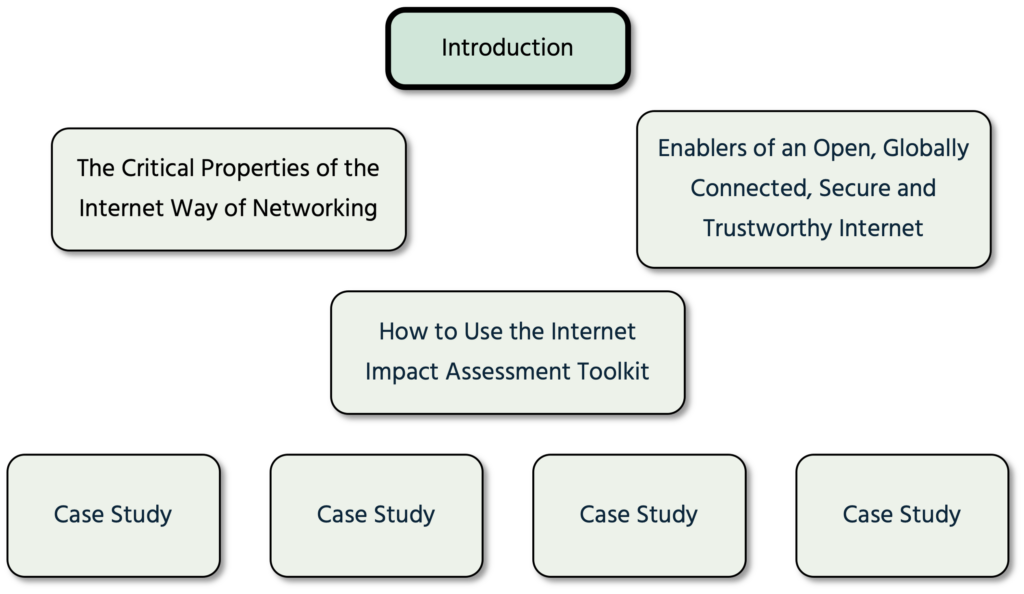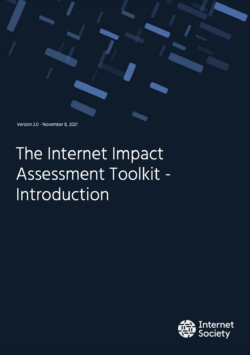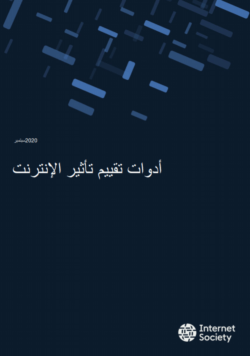Editor’s note: Below is the 2.0 version of the document, published on 8 November 2021. The 1.0 version was initially published on 9 September 2020.
The Internet Impact Assessment Toolkit – the roadmap

Introduction
Like any live ecosystem, the Internet is constantly evolving. This perpetual evolution without a centralized plan or control – but with thousands of people and organizations working collaboratively on standards, protocols, and their application in the real world – is what has made the Internet a success. But as the Internet has come to permeate most of our lives we are facing a new reality in which governments and businesses are increasingly making decisions that could harm the Internet, and they might not even realize it. This is why the Internet Society created the Internet Impact Assessment Toolkit (IIAT). It is meant to help decision-makers of today and tomorrow make better decision about the Internet, and to act as a framework to evaluate whether a proposed change threatens the fundamentals of the Internet.
The Internet Society works to make the Internet bigger and stronger for people everywhere to connect, communicate, and innovate, now and in the future. But it’s not just our privilege to use it. It is up to everyone to protect and support the Internet’s fundamental properties and conditions that make it more open, globally connected, secure, and trustworthy. If not, we risk a series of irreversible and accelerating changes that chip away and ultimately break the foundation underpinning this incredible resource for humanity.
This toolkit is centred around benchmarks for change. It includes a collection of resources that use “the Internet Way of Networking” and “Enablers of an Open, Globally Connected, Secure and Trustworthy Internet” as a framework to test whether new ideas support the best potential of the Internet. The toolkit offers a stable frame of reference to evaluate current networking conditions, proposals for technological development, regulations, and technical governance arrangements. It helps people make better decisions about the Internet by providing an easily applicable lens through which to assess whether a new development supports or undermines what the Internet needs to exist and thrive.
How to Use the Internet Impact Assessment Toolkit
The Internet Impact Assessment Toolkit helps users assess whether a regulatory proposal, trend or technology could impact the Internet. It includes a how-to guide, visual references, and a series of case studies and Internet impact briefs as examples of real-life issues and developments that could impact the Internet.
Internet impact briefs are intended as a first assessment to analyse how a proposal, development or trend could benefit or threaten the Internet. They are meant to help inform multi-stakeholder dialogues, and determine whether certain interventions may warrant in-depth impact assessments to safeguard a thriving Internet of tomorrow.
We invite you to use the Internet Impact Assessment Toolkit to develop new Internet impact briefs on issues that are relevant to your community and share the results. Which technological, policy, and other new developments and trends are affecting the Internet near you? Are they beneficial, or are there risks involved that should they be mitigated or lessened?
The choices we make today help determine the Internet of the future. If those choices are guide by actions to protect what the Internet needs to exist and support what it needs to thrive, its ecosystem will keep its vitality as it continues to evolve.
A Framework for Analysis
What makes the Internet ‘the Internet’? Why has it been adopted so rapidly by so many people across the world? How does it continue to birth and sustain innovations? And what do we want the Internet to be in the future? To ensure the Internet’s continued success we need to know what makes it unique, and what makes it thrive. The Internet Impact Assessment Toolkit uses two technical papers as framework for analysing impact on the Internet. The first describes the critical properties the Internet needs to exist, and the second describes the enablers that help it thrive as open, globally connected, secure and trustworthy resource.
What the Internet Needs to Exist: Critical Properties of the Internet Way of Networking
The Internet is not centrally managed. Intelligence and autonomy are concentrated at the edges, in the hands of those running networks and services. Anyone can enter the Internet, multiplying its connections and increasing their value for all. So it is not just the technology, or its services and use that define the Internet. How we network – what we call the ‘Internet Way of Networking’ – also matters.

The Internet Way of Networking is built from five critical properties that maximize the benefits the Internet brings.
- An Accessible Infrastructure with a Common Protocol
- An Open Architecture of Interoperable and Reusable Building Blocks
- Decentralized Management and a Single Distributed Routing System
- Common Global Identifiers
- A Technology Neutral, General-Purpose Network
These properties are critical both because they are necessary for the Internet’s healthy evolution and because they convey what makes the Internet unique.
It’s important to note that the Internet’s critical properties may have never existed in their purest form. The critical properties don’t harken back to an idealised past. Instead, they represent the Internet’s optimal state. By codifying the basics of the ideal Internet model, we have a reference point that helps us tell whether this model is moving away from or towards the best it can possibly be.
Each of the Internet’s critical properties helps to sustain particular benefits that the Internet can produce. When they are present, they help maximize both the Internet’s health and its potential to create and disseminate value. For example, unrestricted access and common protocols deliver global connectivity, and encourage the network to grow. As more and more participants connect, the value of the Internet increases for everyone. Another example is a single identifier set that delivers consistent addressability and a coherent view of the entire network, without fragmentation or fractures.
While the Internet’s critical properties cannot guarantee the associated benefits, together they form the necessary condition for future evolution in a way most likely to create and disseminate the value that comes from connection.
What the Internet Needs to Thrive: Enablers of an Open, Globally Connected, Secure and Trustworthy Internet
The critical properties describe the foundation the Internet needs to exist – and illustrate why it is unique from other networking models. However, to help the Internet thrive we need another set of conditions that enable it to reach its full potential. This potential can be expressed by a set of goals for the Internet.

Time and time again, different groups in different parts of the world with different viewpoints keep coming back to a common set of such aspirations:
- An Open Internet that allows everyone to participate with a minimum of barriers, to use it, to innovate, and to grow and sustain the Internet as a force for good.
- A Globally Connected Internet that is inclusive, allowing everyone to interconnect without geographical restrictions and use the full power of the network.
- A Secure Internet that survives attacks, that supports everyone in maintaining integrity and confidentiality of the data. A secure Internet also means that its use does not create insecurity, such as botnets that are used in phishing scams.
- A Trustworthy Internet that people can depend on to be there, so that the Internet can be a base for worldwide services, everything from recreation to commerce to information.
These four goals become guidelines for us on our journey to a better Internet. They tell us what we want the Internet to be, now, and in the future.
These Internet goals are aspirational statements and because of their broad and abstract nature, it is difficult to use them to analyse how various developments may impact the Internet. To aid this analysis, for each of the Internet goals, we have identified a series of supporting characteristics: things that progress or hold back the Internet’s growth and its global goals. Generically, we call these supporting characteristics “Enablers”: they advance and enable the targeted goal.
|
Goal |
Enabler |
|
Open |
Easy and unrestricted access |
|
Unrestricted use and deployment of Internet technologies |
|
|
Collaborative development, management, and governance |
|
|
Globally Connected |
Unrestricted reachability |
|
Available capacity |
|
|
Secure |
Data confidentiality of information, devices, and applications |
|
Integrity of information, applications, and services |
|
|
Trustworthy |
Reliability, resilience, and availability |
|
Accountability |
|
|
Privacy |
We may never reach a point where we can say that the Internet is fully evolved, or that we’ve reached our goals. But we can move together in a direction that makes the Internet more open, more connected, more secure, and more trustworthy, for everyone. The enablers of a thriving Internet help us understand what needs to be protected and enhanced.
An Impact Assessment for the Internet
Around the world, networking models are emerging that constrict inter-networking and aim to systematically organize the Internet into a permission-based network. More authoritarian countries seek to export their visions for the Internet, with gated access, security restrictions, and policies that impede growth. Elsewhere, concerns have arisen about significant business players’ influence over important parts of the Internet, its direction, and its infrastructure.
All these developments threaten the healthy evolution of the Internet.
To conduct an Internet Impact Assessment is to systematically consider the implications of change. It is our belief that this toolkit can do just that:
- By mapping the effect of a new developments against the Critical Properties of the Internet Way of Networking we learn about its implications for preserving a networking model that has proven its unique value as a global platform for innovations and socio-economic progress.
- By analysing the impact on the enablers we can understand the implications for an open, globally connected, secure and trustworthy Internet.
We hope you find the framework of the Internet Way of Networking and the Enablers both a useful expression of ‘what makes the Internet the Internet’, and a practical tool to help support its healthy evolution for everyone.
Related resources:

